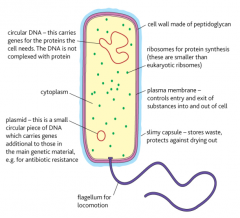![]()
![]()
![]()
Use LEFT and RIGHT arrow keys to navigate between flashcards;
Use UP and DOWN arrow keys to flip the card;
H to show hint;
A reads text to speech;
23 Cards in this Set
- Front
- Back
- 3rd side (hint)
|
Monera kingdom type of cell |
prokaryotic - lacks membrane bound organelles |
|
|
|
uni or multi celled? |
most are unicellular |
|
|
|
nutrition |
autotrophs-make their own food by photosynthesis. heterotrophs-use the energy in some chemical compounds to produce food saprobe and parasites- some cannot produce their own food. |
|
|
|
saprobe |
feeds on matter from dead organism feed on the waste of organism ex. the bacteria that feds on your sweat on your skin are saprobes. |
|
|
|
parasites and hosts |
parasite: the one that hurts the host on witch it feeds. host : the one getting fed on. bacteria that act as parasites include that cause diseases cholera, small pox, and the bubonic plague. |
|
|
|
locomotion |
flagella and cilia |
|
|
|
cell wall? |
some but not all |
|
|
|
examples of moneras |
bacteria and blue- green algae |
|
|
|
phylums |
2phya bacteria and cyanobacteria |
|
|
|
characteristics |
no nucleus smallest and simplest kind of living thing more moneras than any other organism |
|
|
|
structure of the bacteria what are the parts? |

ribosomes dna cell wall capsule flagelum plasmid chromosomes cell membrane |
|
|
|
cocci bacteria |
sphere shaped an example is bacteria that cause strep throat. |
|
|
|
bacilli bacteria |
rod-shape certain bacteria that live in your stomach are bacilli bacteria |
|
|
|
spirilla bacteria |
spiral shaped best known, cause diseases spirillum minus |
|
|
|
respiration |
aerobe: needs oxygen anaerobe: dosent need oxygen bacteria get their energy from breaking down of food in the process of respiration. some bacteria need oxygen to brake down their food and some do not. |
|
|
|
reproduction |
reproduction is by fission fission is the simplest form of asexual reproduction y just one parent |
|
|
|
sexual reproduction |
the process in which one bacteria transfers genetic material to another through direct contact. |
a.one bacteria transfers genetic material to another b.the two cells are separated c.the bacteria then divides by binary fission d. results in genetically different bacteria. |
|
|
what is an endospore |
a small round, thick walled protective structure that forms inside a moneran cell during unfavorable conditions .it contains genetic material and some cytoplam. |
|
|
|
are bacteria dangerous |
most arent, but some can make you sick. those are called pathogens |
|
|
|
pathogens can cause ..... |
dieases in animals and plants. ex. leprosy, food poisoning, pneumonia, tetanus. |
|
|
|
are all bacteria bad? |
not at all, most bacteria are very helpful to us. they play an important role in the plants ecosystem. |
|
|
|
bacteria in food? |
yes there is.used when making food like yogurt,cheese , pickles and soy sauce. |
|
|
|
bacteria in our bodies |
a bacteria can help us digest our food soma assist our immune system. |
|

